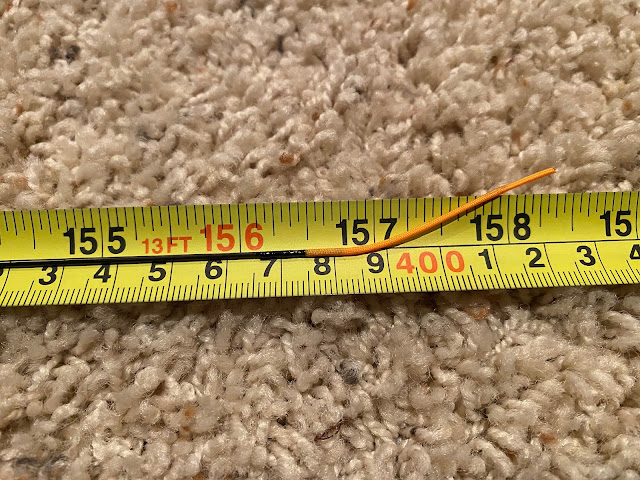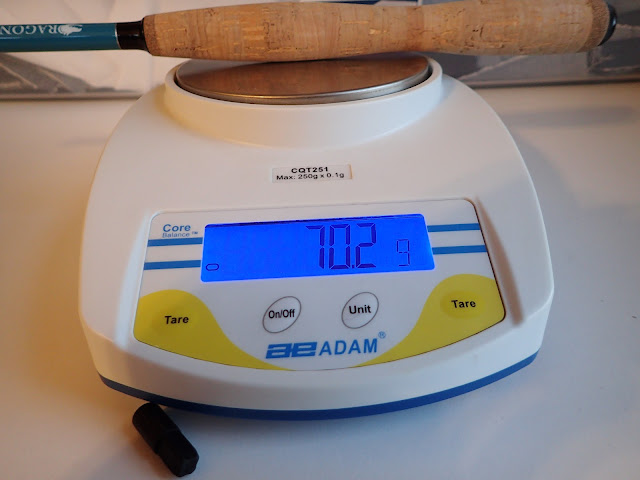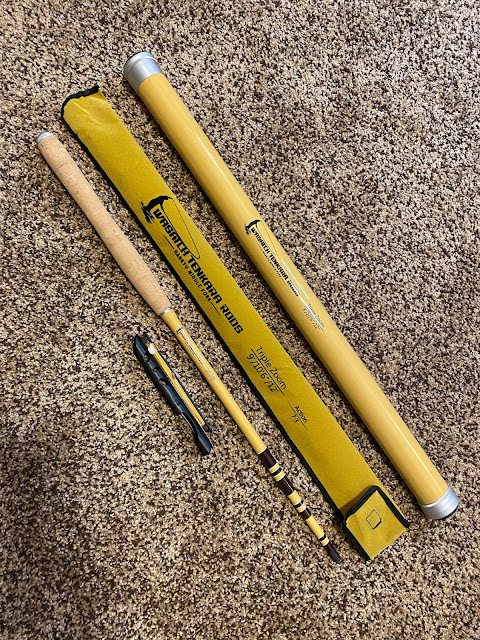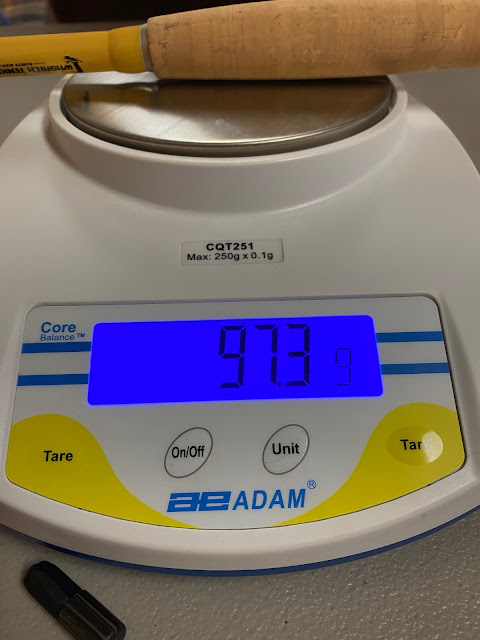March 27, 2022
March 24, 2022
Riverworks ZX4-PRO review (Updated)
To see addenda updates, skip to the end of the review.
I've been doing rod reviews long enough to have see quite a few tenkara rods. I've seen some pretty high end rods, as well as many that were not so high end. But each time I see one of the high end rods, I'm pretty much in awe as to the aesthetic beauty and craftsmanship that some rod makers achieve. The rod reviewed in this post is no exception. It's the Riverworks ZX4-PRO.
Riverworks Rod Company is a custom, made to order, rod manufacturer based in Signal Mountain, Tennessee, USA. Jeff Lomino is the owner/CEO and is the main rod craftsman and artist. He has the reputation of fine detail craftsmanship and on being a stickler for quality. He made a series of tenkara rods in the past, but the culmination of years of study and research has yielded the ZX4-PRO. With input from Rob Worthing, the ZX4-PRO is designed to be at the pinnacle of tactical nymphing rods available. Here's what Riverworks says on their website: "After 4 years of development and testing dozens of prototypes, Rob and I finally have what we both believe is the ultimate rod for fishing with weighted nymphs using the Tactical Nymphing ideology. The ZX4-PRO 395CM (13') was meant to emulate all the positive aspects of the ZX3 360CM (12') rod with several meaningful improvements. Longer reach...Added leverage...Lighter overall weight. We use the term PRO in the title for the ZX4 because this is not a beginner's rod. It is however a rod that a beginner can grow into as his/her skills improve. Rob and I believe, simply put, there is no better rod on the market for Tactical Nymphing. "
Here are some specifications from Riverworks:
LENGTH 395CM (13')
WEIGHT 3.30 OZ (94 Grams)
MATERIAL Japanese Toray 40T Carbon Fiber Cloth with nano resin system
GRIP American 4K Biaxial Carbon Fiber Sleeve with West Marine Epoxy. Poly/Carbon (7lb density) Core.
ACTION Fast Action Butt Section, Medium-Fast Mid-Section and Tip
The ZX4-PRO came to me shipped in a PVC tube. Inside, the rod was heavily bubble wrapped for protection. Included with the rod was a black neoprene rod sleeve, and an extra top two sections.
My rod has an overall very dark graphite grey (almost black) coloration. The blank is unsanded and has a slightly glossy finish. The rod designation is white lettering on a black background and is covered by a very generous epoxy layer. The tip of the handle section has a prominent epoxy reinforcement that is symmetrical and beautifully done.
The handle is black polyurethane/carbon foam with an overlying carbon fiber sleeve (* see the addendum 1 at the bottom of the review). Rob Worthing states this material is lighter than EVA foam, but since I don't have any to compare, I can't substantiate such a claim (** see addendum 2 at the bottom of the review). The contour is a very subtle double camel or hourglass shape. The handle is substantial in diameter and fully fills the palm of your hand. It's overall length is 29.5 cm (11.6 inches).
The tip plug is black nylon plastic and it fits snuggly into the handle section of the rod. It includes a loop of lilian material. The butt cap is black anodized metal and is knurled to aid removal. There is no decompression hole or coin slot.
The lilian is yellow-orange and is attached to the tip section via a perfectly executed glue joint. The tip section can be fully removed through the second section (Japanese convention dictates the tip section to be section #1) so that the rod can be fully disassembled for cleaning and drying. The lilian comes without the ubiquitous terminal knot.
Here are my measurements:
Fully Nested (with tip plug): 63 cm (24.8 inches)
Fully extended: 398 cm (13 ft, 0.7 inches)
Weight (without tip plug): 96.8 g (3.4 oz)
CCS: 19 pennies
RFI: 4.8
Casting the rod is a pleasure. The Tanuki blank is smooth and responsive. It has no overshoot, tip oscillation, or other aberrances. Dampening, both linear and rotational, is excellent. and rod recovery is near perfect. Although the ZX4-PRO has a somewhat similar blank as the Tanuki Shinobi I reviewed, the Shinobi that I reviewed was shorter and a little stiffer. The current Shinobi Traditional LE has the same blank as the ZX-4 PRO.
I used a 14' #3 level line, and the ZX4-PRO throws that line with smooth conviction, landing the fly first every cast.
The balance is excellent, but due to the weight of the rod, starting and stopping the cast is not effortless. This is a substantial rod at 96.8 grams. It's overall inertia is not as large as some of my rods, but it's more than others.
The handle is interesting. It's quite large in diameter, compared to other rods, and I could see that being an issue for some folks. I wear size XL gloves and like thicker handles, but this handle is even a slight bit thick for me. Maybe I just need to get used to it. The texture imparted by the carbon fiber sleeve is definitely grippy and gives plenty of tactile feedback. Does the polyurethane/carbon foam with carbon fiber overlay make it "better" than just plain foam or even cork, I don't know.
Fishing the ZX4-PRO is fun. It is well balanced and causes very little arm fatigue after a few hours a steady fishing. I used the ZX4-PRO on a tailwater using a two tungsten nymph rig. I found that the rod casted the heavy flies really well and hook sets were good. Personally, I prefer a rod that is a little stiffer and has a little quicker hook set for my contact nymphing (RFI 5.8-6), but this is just a personal preference. I took rainbows up to 14 inches and the rod handled these with no issues, despite moderately heavy current. I did hook a few larger fish, but I think they were carp or large suckers (by the way they fought) and they broke me off before the rod could turn them.
Conclusion: I like this rod. It casts a level line beautifully and is accurate when using both weighted and unweighted kebari. But casting the ZX4-PRO is reminiscent of other rods I have used. In fact, the weight, casting inertia, rotational moment, flex action (RFI), handle length and handle diameter reminds me of the Discover Tenkara Karasu 400. I bet if I were blind folded, I wouldn't be able to tell the difference between the two (except for the texture of the carbon fiber overlay on the ZX4). And as far as that carbon fiber sleeve-over-poly/carbon foam handle goes, I'm not sure I see its advantage over just foam or cork. However, the texture is quite nice. Again, Rob Worthing claims that the handle is lighter than EVA foam, but since I don't have a comparison rod with EVA foam I can't measure that. So, we'll have to just put that statement into the "magic sauce" category. (** see addendum 2 below for an update).
Overall, I think Jeff Lomino and Rob Worthing have designed a beautiful rod that is worth the premium price ($449.00 USD), and Tanuki has made a wonderful blank. Since both Rob and Tanuki are students of Masami Sakakibara, I can definitely see the Oni influence on the action of the ZX4-PRO. I bet you'd love the rod if you decided to purchase one. This rod combines world class craftsmanship with flawless design and quality materials, and it shows!
Disclaimer: My opinion regarding this rod is just that, my opinion. Your opinion may differ. Also, your rod may not have the same length, issues, or functionality as my rod. There are variations between rods, even in the same production run. No description can fully tell you how a rod feels or fishes. For this, you must personally hold, cast, and fish the rod, then make up your own mind. I ordered and purchased the ZX4-PRO rod in this review from Riverworks Rod Co.
*Addendum 1 from Jeff Lomino - "These grips are actually built on a polyurethane/carbon foam core with a carbon fiber sleeve overlay . Everything is fused together with premium vinyl ester resin.. The EVA foam visible on the front and rear of the grip are caps that prevent the hard carbon fiber grip from rubbing against the blank."
** Addendum 2 (January 6, 2023) - Since I published this review, I bought a Tenkara Tanuki Shinobi Traditional LE. This has the exact same blank as the ZX-4 PRO 395, but has a wood accented high density EVA foam handle. Interestingly enough, the Shinobi Traditional weighs (without the tip plug) 84 g (2.96 oz.), 12.8g (0.45 oz.) less than the ZX-4 PRO 395. It also has a slightly better RM at 6.9 vs. 7. Extended length and RFI is exactly the same, as you'd expect, being the same blank. Also, in my hands, the sensitivity feels equal. So, does my data support the claim that the Riverworks custom handle is lighter and better than high density EVA foam? In my opinion, no. It's just a different style of handle.
March 20, 2022
March 15, 2022
Is Tenkara (Really) Getting Too Complicated?
I recently read a blog post by Jason Klass on Tenkara Talk, where he asked the question if tenkara was getting too complicated. Jason was an "early adopter" and is a highly respected tenkara personality and influencer. He is the author of numerous articles on tenkara, and has done presentations at tenkara gatherings and summits. His blog, Tenkara Talk, is, as I have written before, the best overall source for information on tenkara related techniques, philosophy and opinion.
But Jason and I don't always agree on everything in the "tenkaraverse". He is apparently not a fan of objective data when it comes to choosing a tenkara rod.
Rather than summarize his argument and running the risk of misrepresenting his view, I'll let you read his blog post. For what it's worth, I did write a response/comment on his article, but I since there's a chance it might get moderated out, here's a screenshot of what I wrote (bad grammar and all):
OK, I'll admit that what I wrote was a little too sarcastic. I freely admit that. But I do think my last few statements have merit. I do think you can have more than one approach to choosing a tenkara rod. If a person doesn't want to read reviews on a product, they don't have to. They can keep it simple and just "take a risk" and buy that product. If a person doesn't want to look at the data for any given product then they don't have to. I'm sure that would work well when buying a car (I know, tenkara rods are not cars, but you get my point).
I publish my rod data for anyone who would like more information on a rod than what is provided by the rod company (which is often biased and not fully transparent). My data doesn't replace the purchasing risk, it just gives a little more information before you take that risk. If you want more data, then look at the data. If you don't, then don't. But I do agree, buy a tenkara rod and go fishing!
Anyway, I fully support Jason in his opinion. But that opinion is not mine, and I just wanted you to see what I wrote. And remember, it's not him versus me, there can be both. Cheers!
March 13, 2022
March 10, 2022
ANGLE Lure & Fly Miyama36 tenkara rod to be released
A fishing company in Japan, called ANGLE Lure & Fly, is releasing a new tenkara rod. Called the MIYAMA36, it is designed for beginner to intermediate tenkara anglers.
It has a unique handle design, spiraled carbon fiber blank, and a 7:3 action. Its extended length is 360 cm (11.8'), nested length is 47 cm (18.5") and weight 96 g (3.4 oz). The introductory price is 11,000 yen. If you have interest in this rod, you could contact a Japanese fishing equipment agent, such as Tenkara-Ya or Plat, to get further details and availability.
March 6, 2022
March 3, 2022
DRAGONtail Kaida zx320 Pack Tenkara Rod - preview
It seems that tenkara goes through cycles just like traditional fly fishing. Not to many years ago, pack rods were all the rage, then the fervor died down for a while. But once again, the clammer for pack rods has resurfaced.
To answer the appetite for pack rods, Dragontail Tenkara is releasing the Kaida zx320. Kaida means "little dragon" and it appears that this little rod will be just the thing for many people. Like the Dragontail FoxFIRE zx280, the Kaida is a carbon-glass composite rod, but unlike the FoxFIRE, the Kaida's glass is incorporated into the carbon using a different technique. This process is so special that Brent and Brandon from Dragontail wouldn't tell me how it was done. They told me some things, but I have to take that information to my grave. Needless to say, it appears Dragontail has cracked the once challenging carbon-glass composite mystery!
The Kaida is a single zoom rod pack rod, with fishable lengths of 285 and 320 cm. The rod's overall coloration is carbon black and the finish is matte. The handle section has a turquoise accent where the brand label is place. There are small accent bands on the tipward sections of the upper segments.
The handle is cork with a camel or gourd shape reminiscent of the FoxFIRE. The handle length is 23 cm. A ring of cork composite is placed at the tip and butt positions of the handle.
The tip plug is wood with a rubber insert. The butt cap is black nylon plastic, is knurled, and has a coin slot. No decompression hole is present. A universal tip cap is also provided.
The lilian is red, and is attached to the tip section with a micro-swivel. The glue joint is executed well and so the entire rod can be disassembled for cleaning and drying.
Here are my measurements:
Nested (with tip cap): 45.5 cm (17.9")
Extended: 285 cm (9' 4") / 317 cm (10' 4.8")
Weight (without tip cap): 70.2 g (2.5 oz)
CCS: 14 / 16 pennies
RFI: 4.9 / 5
Casting the Kaida pack rod is a joy. The rod has an RFI that I prefer (right around 5) and the action is smooth and unlabored. I used a #3 level line from 8 to 14 feet, and the rod cast these lines effortlessly. There is no overshoot or tip oscillation. Dampening is very good. Balance is excellent, as you would expect from a short rod. Basically, it's a fun little rod!
The Kaida is less whippy than the fully extended FoxFIRE. Even though the Kaida is a carbon-glass composite rod, it fundamentally acts more like a carbon fiber rod than a glass rod, given how the glass is incorporated into the rod blank.
I didn't get a chance to fish the Kaida, because all of my small creeks are frozen over. But I look forward to fishing this rod when the appropriate water becomes available. I know just the creeks to try it on!
Conclusion: I like this rod! Although I don't need a compact tenkara rod (most tenkara rods are compact enough for my needs), I can see where someone would want an even more compact rod to take in their car, backpack, bike, on walks, etc. Most compact tenkara rods are either way too stiff to be fun, or way to fragile to be useful, but the Kaida zx320 pack rod is neither. Its flex action is excellent, and with an RFI of 5 it will handle fish better than a softer rod. With its proprietary carbon-glass composite, the Kaida bridges that stiff carbon and whippy glass frontier with a breakthrough pack tenkara rod design that any blueline tenkara angler would enjoy owning!
Note: As of publication, the Kaida zx320 is in pre-production and is not yet available for purchase. The release date is anticipated to be the summer of 2022. Contact Brent at DRAGONtail for further details and updates.
Disclaimer: My opinion regarding this rod is just that, my opinion. Your opinion may differ. Also, your rod may not have the same length, issues, or functionality as my rod. There are variations between rods, even in the same production run. No description can fully tell you how a rod feels or fishes. For this, you must personally hold, cast, and fish the rod then make up your own mind.
I borrowed the rod from DRAGONtail Tenkara for the review, and returned it after the review. I have no formal affiliation with DRAGONtail Tenkara, and there was no expectation of a positive review.
March 1, 2022
Wasatch Tenkara Hankyu Middle Fork Tenkara Rod
I recently received the Wasatch Tenkara Hankyu Middle Fork 7:3 Tenkara rod from Ruben Garza. Wasatch Tenkara rods goal is to make tenkara rods that are nearly impossible to break under normal conditions. I've reviewed the Daikyu T-Hunter and the Maruki Sharpshooter in the past, and have found them to be robust and capable rods. With that, I expect the Hankyu Middle Fork will be the same.
The Middle Fork came with a standard rod sleeve and tube. The rod was prestrung with nylon level line, tippet, a foam indicator and a #16 Tungsten Surveyor. Ruben said that the Middle Fork will be shipped to customers ready-to-fish. The line, tippet and fly were attached to the lilian via a slip knot and wound onto a snap-on line holder.
The rod coloration is light yellow with brown accent rings. The finish is glossy. It is a double zoom rod with fishable lengths at 9'/10' 6"/ 12'. The zoom action was smooth and repeatable. The handle is cork and has a mild gourd or camel shape that fits the hand well. The handle is 23 cm in length (9 1/16").
The tip plug is wood with rubber insert post. It fits into the rod snuggly. The butt cap is silver anodized metal and has a standard zoom post with O-rings. It is knurled for easy removal, but has no coin slot or decompression hole.
The lilian is dark brown, is attached to the tip section via a micro-swivel, and has a pretied terminal knot.
Here are some of my measurements:
Nested (with tip cap): 57 cm (22.5")
Fully extended: 278.5 cm (9' 1.6") / 321.5 cm (10' 6.6") / 362 cm (11' 10.5")
Weight (without tip plug): 97.3 g (3.4 oz.)
CCS: 28 / 29 / 29 pennies
RFI: 10 / 9 / 8
I found the Hankyu Middle Fork 7:3 to have a very fast action, on par with the Maruki Sharpshooter, and less so with the Daikyu T-Hunter. Whereas the T-Hunter has a pleasing and responsive action (RFI of 5.6-5.9), the Middle Fork is very fast (RFI of 8-10). This is more inline with 8:2 ratio rods than 7:3 rods. Because of this, casting a level line can be challenging unless it is cast using a weighted fly and indicator, as it is sold. Given the rod's fast action and tested materials, I suspect it meets Wasatch Tenkara's goal of being very robust and handling large fish. In fact, some folks in Pennsylvania are already using the Middle Fork to fish for and land Great Lakes Steelhead! That takes a tough rod!
So, if you are in the market for a medium length zoom rod that is designed to be both robust and powerful, then the Hankyu Middle Fork 7:3 Tenkara rod could be just what you're looking for. It would not be a finesse rod, but it could probably handle anything your likely to come up against in small to moderate sized streams.
Update: Ruben states that he has designed a 6:4 version of the rod and that it should be available this spring. I look forward to seeing that rod and others of his lineup.
Disclaimer: My opinion regarding this rod is just that, my opinion. Your opinion may differ. Also, your rod may not have the same length, issues, or functionality as my rod. There are variations between rods, even in the same production run. No description can fully tell you how a rod feels or fishes. For this, you must personally hold, cast, and fish the rod then make up your own mind.
I was loaned the rod from Wasatch Tenkara Rods, and returned it after the review. I have no formal affiliation with Wasatch Tenkara, Rods and there was no expectation of a positive review.













.png)
.png)


































